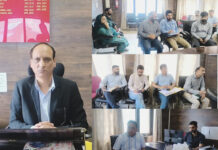34-yearman presented with exertional breathlessness and palpitations for 3 months duration. After thorough examination and investigations, a diagnosis of Large Ostium Secundum ASD with Mild PAH was made. Transesophageal echocardiography (TEE) showed dilated RA and right ventricle (RV), moderate tricuspid regurgitation, pulmonary artery systolic pressure of 35 mmHg, 22 mm ostium secundum ASD, with inadequate aortic rim.Patient was advised for either open heart surgery with patch or closure of the hole using the groin i.e. percutaneous transcatheter device closure somewhat similar to angiography.Using Groin (Femoral vein) as access, the catheter was advanced across the defect into the LA; and26 mm Amplatzer ASD devicewas released across the defect and the hole was closed. Post procedural TEE showed the device in situ with no residual leaks/shunt. The patient made an uneventful postprocedure recoveryand was discharged homewithin 48 hrs of admission. Transthoracic echocardiography(2D Echo) was performed prior to discharge and was normal.
Explaining about the case Dr Sushant Kumar Senior Consultant Cardiologist said that the incidence of isolated ASD has been estimated at 1:1,500 live births, which is about 6% to 10% of all varieties of congenital heart disease.Atrial septal defect (ASD) is one of the more commonly recognized congenital cardiac anomalies presenting in adulthood classified into different typesdepending on the location of the defect. It is characterized by a defect in the interatrial septum (Hole in the heart), allowing pulmonary venous return to pass directly from the left atrium (LA) to the right atrium (RA). Cardiac sequelae depends on the size of the shunt and associated anomalies, which can range from no sequelae to right sided volume overload, pulmonary artery hypertension, and atrial arrhythmias.
The traditional method of closure has been surgical, which has been practiced for more than 50 years. With advancement in surgical techniques practice has moved to minimal invasive surgical approach, including minimal skin incisions, reduced opening of the thoracic cage thus allowing faster rehabilitation but still requires 4-5 days of hospital stay with due surgical procedure risk.
The development of catheter-based technology has made device closure the first option for closure of ostium secundum ASDs except those with insufficient rims to secure the device and those with coincidental anomalous pulmonary venous return. Obvious Advantages include minimal risk of infection because of short hospital stay (24-48hrs), neglible blood loss, no need of operation, cosmetic reasons especially in females (no scar marks), patients deemed unfit for surgery with multiple comorbidities. Long term benefits are similar to surgery. However,Ostium primum and sinus venosus ASDs are more suitable for closure under direct vision with cardiopulmonary bypass (Open Heart Surgery). I would like to extend my gratitude and thank my team including Anaesthetist Dr Santosh, Dr Badyal, ICU Consultants & Nursing Staff,Cath lab team and hospital management for providing the necessary support to carry out this procedure.
Though the procedure is now routinely done in other parts of the country, it is not yet popular in Jammu. To the best of our knowledge, this is the first reported case of transcatheter closure of ostium secundum ASD with deficient aortic rim in Jammu. Before now, patients with ASD in Jammu have been unable to access a definitive, nonsurgical cure locally, often having to face the severe financial burden of seeking this mode of treatment outside the state. Such patients can now benefit from this procedure at much less cost with the speedier recovery due to removal of the stress of travel and an unfamiliar environment he quoted further.



























